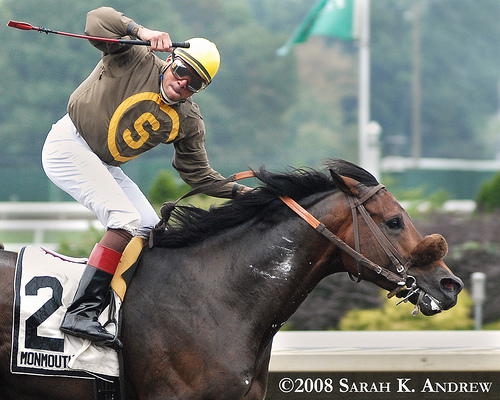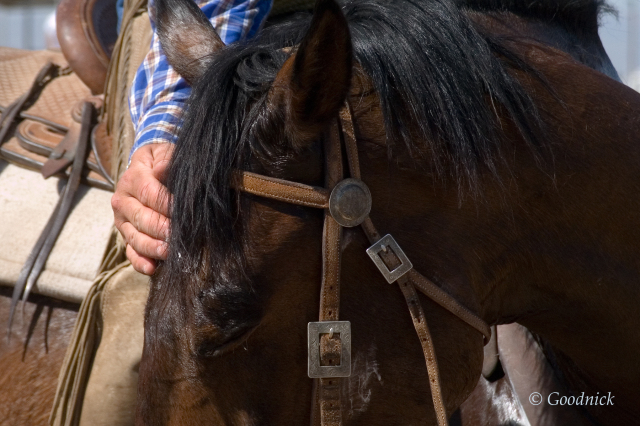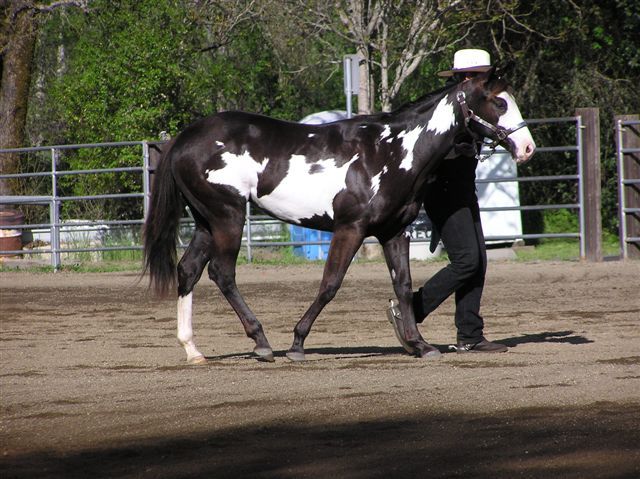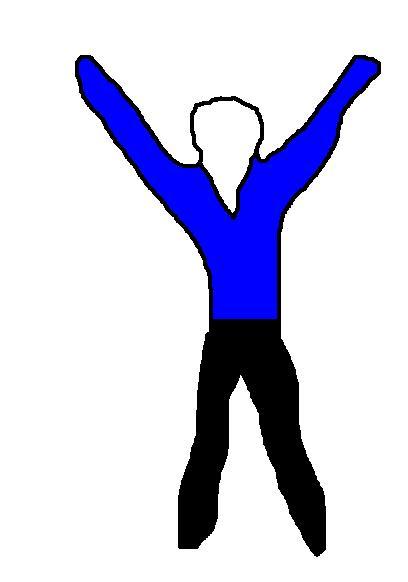QuestionI have an off track TB mare that I purchased two years ago with the intention of breeding. Life has changed and so I need to sell this mare as she no longer fits my program. I know her chances are better if she is trained undersaddle rather than just a broodmare. She is perfectly sound, boss mare (natural not aggressive), and a quick leaner. She does require everything step by step with constant praise. Just the words good girl get immediate response. I've been working her the last month on the ground with brushing, tying, lunging and round pen work. We are making excellent progress. I will say that she's obviously had some serious rough treatment in the past. My first time picking up a whip she panicked. In this case I was merely picking it off the ground to return it to the barn as I was bringing the mare in.
The difficulty came when the first time saddling. She stood perfectly still while I saddled her and then put on the bridle. I put a simple full cheek snaffle over a halter. I was planning on lunging her outside. Suddenly she exploded, I managed to get out of the way and she went down. She got back up and stood. I took off the bridle but left the saddle on for a short while in the stall. She seemed stiff but didn't act up anymore so I thought maybe an outside source was the problem. I unsaddled her and brushed her with no problems.
Next day I decided to try again. Groom, no problem, saddle, no problem, bridle, lungeline, no problem. Then move one step and again, explosion. This time I had the lungeline so I was able to control her movement. She backed up until she met resistence then stretched out like she was bowing, then just collaped on the ground. She laid there while I went up and removed the bridle once again. It was about two minutes before she got up and then she bucked one and skittered about for a few seconds and then just went back to normal. This third morning she just hunched up and threw herself back but recovered quicker.
All three times after the initial first reaction she doesn't act up anymore, even when lunged or round penned. Only the first minute is there any problems. She does seem stiff when moving, though tracks up and reverses fine. I'm at a loss, if its just time, no problem, but I'm worried there might be a nervous system problem, though I really don't want to spend a truckload of money to find out there is nothing wrong. Is there anything I can look for before calling a vet?
AnswerThis sounds like your horse is reacting to pain somewhere in her withers, barrel or back.
1) Carefully check her back and her barrel for sore muscles. Run your fingers along her back from the withers to her croup using a gentle pressure with 2 or 3 fingers about 1" from her spine. Go slowly and watch for any flinching, twitching, tensing or dropping of the muscles. Then do the same in the area where the girth goes on the sides and underneath her barrel. Do this on both sides.
2) Carefully check the fit of her saddle. Place the saddle on her back without a pad and without doing it up. Push down on the centre of the saddle (where your weight would be when riding) with one hand and slide your other hand under the front of the saddle where the tree points are. On an English saddle, you can find the point of the tree by looking at the little button under the small skirt near the pommel of the saddle. On a Western saddle, it is where the conch is near the horn. Your hand should slide in fairly easily without feeling squished or any pressure points.
Next slide your hand under the saddle & along your horse's back from the front to the back of the saddle feeling for any gaps in contact between the saddle & her back. Gaps mean the saddle is bridging and will be putting pressure on the withers and/or the back.
Look at the space at the front of the saddle over the withers. You should be able to slide at least 3 fingers (4 is better) between the top of the pommel and the withers. Also check that there is enough space along the length of the tree so that the pressure of the saddle is about 2 fingers width from the spine on either side. The saddle should not touch the spine at all.
3) Carefully check the condition of the saddle, girth & bridle to ensure there are not sharp points or areas of ware that could cause discomfort to your horse.
I highly recommend that you have a vet, chiropractor and/or massage therapist take a good look at this mare to resolve any physical problems.

 foamy sweat
Question
foamy sweat
hello maam, is this foamy s
foamy sweat
Question
foamy sweat
hello maam, is this foamy s
 trotting on the road
Question
road
hello. i am rohit from india. i ha
trotting on the road
Question
road
hello. i am rohit from india. i ha
 What is and isnt respect
QuestionQUESTION: Denise, my 2 yr old filly is doing we
What is and isnt respect
QuestionQUESTION: Denise, my 2 yr old filly is doing we
 western pleasure lope and head set
QuestionQUESTION: Dear horsehuman,thanx so much for tak
western pleasure lope and head set
QuestionQUESTION: Dear horsehuman,thanx so much for tak
 throwing hands into the air
Questionthrowing hands into th
QUESTION: hello s
throwing hands into the air
Questionthrowing hands into th
QUESTION: hello s